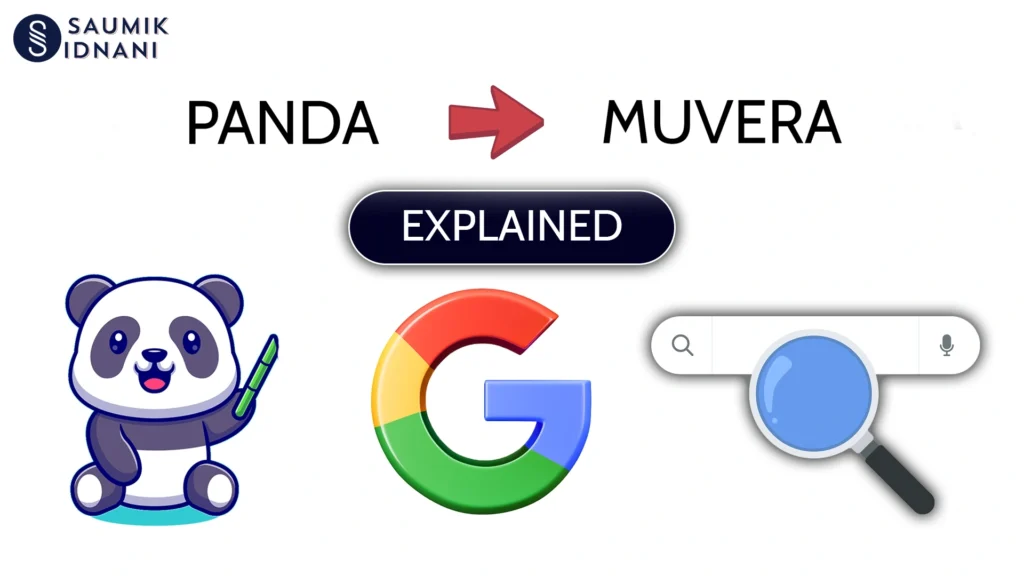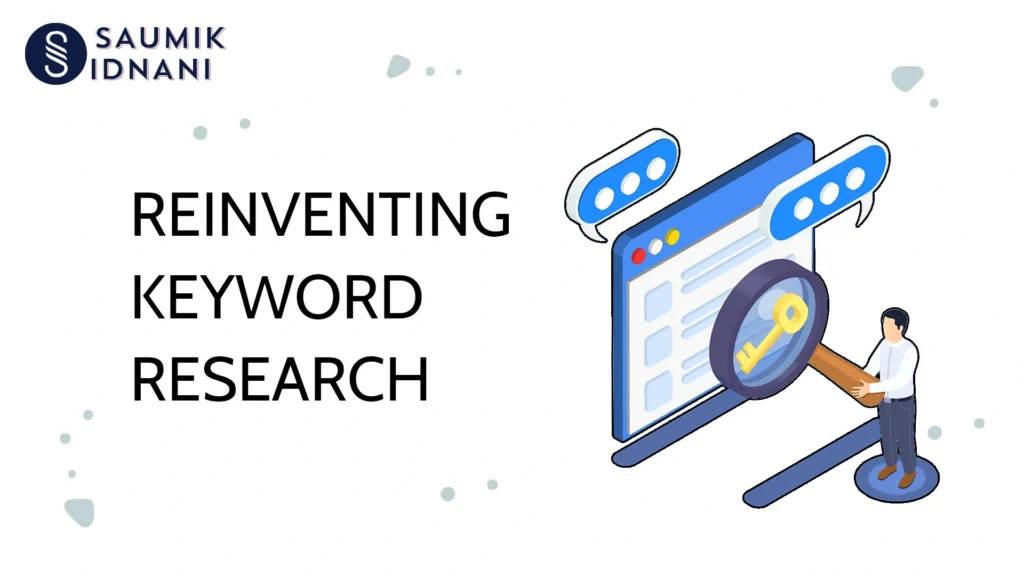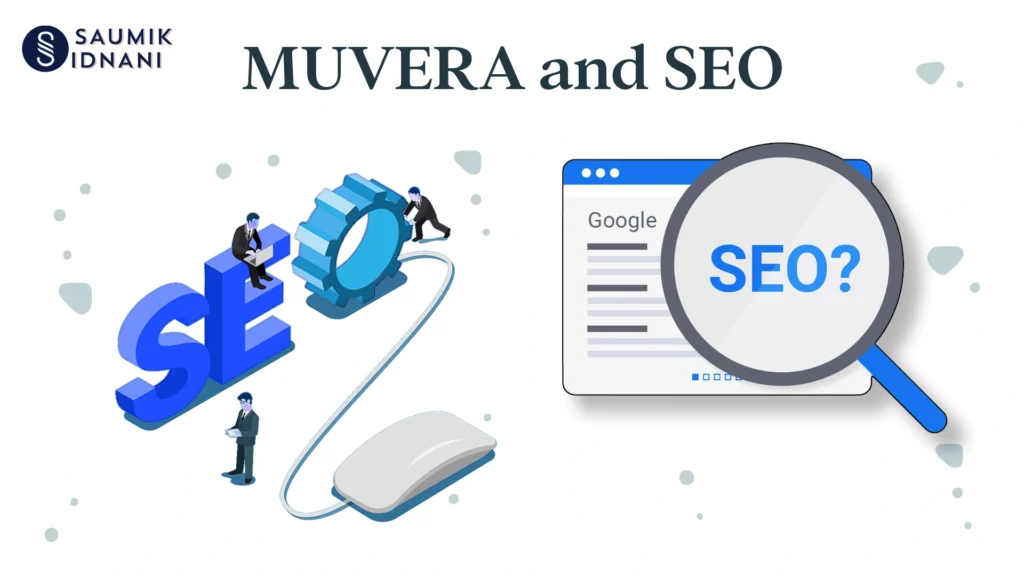Search Engine Optimization (SEO) has always been a dynamic field, evolving with each new update from Google. But 2025 marks a monumental shift with the latest Google algorithm update-MUVERA. So, What is MUVERA? This new update doesn’t just tweak the search landscape; it redefines the process of SEO from the ground up. Whether you’re a digital marketer, local business owner, or SEO specialist, understanding the SEO optimization process post-MUVERA is essential to stay competitive. In this in-depth guide, digital marketing expert Saumik Idnani breaks down the seismic changes brought by MUVERA and how you can adapt using smart strategies like content cluster strategy, long tail keyword research, and local search engine optimization.
At the heart of the latest Google algorithm update, MUVERA prioritizes user intent, semantic relevance, and contextual value over surface-level keyword stuffing or outdated backlink tactics. Google is now analyzing web pages with more depth, factoring in elements like topical authority, user experience, and structured content. For this reason, content creators must shift from creating isolated blogs to building a strong content cluster strategy-where related pages support a central pillar topic. This shift significantly alters the traditional process of SEO, placing more emphasis on quality, relevance, and structure.
Another crucial change lies in local SEO optimization. Google has elevated the importance of Google Business Profiles, especially for “near me” and voice searches. If your goal is to optimize your Google Business Profile and boost visibility in your local area, you must now go beyond the basics. Google is favoring updated, accurate, and actively managed profiles. Features like reviews, FAQs, and location-specific content can now make or break your position in the local search engine optimization ecosystem.
The backbone of success in 2025 lies in effective long tail keyword research. Gone are the days when generic, high-volume keywords alone drove traffic. Today, Google values user-focused, intent-driven phrases that match conversational queries. A well-executed keyword strategy, backed by user behavior data and semantic clustering, is key to navigating the new SEO terrain.
In this comprehensive guide, Saumik Idnani explores every angle of the MUVERA update, sharing actionable tips and best practices to help you thrive in this new era of SEO. From adapting your content structure to enhancing your local presence, let’s dive into how to reshape your strategy and succeed in the post-MUVERA world.

From Panda to MUVERA: The Evolution of Google Algorithm Updates and What It Means for SEO Strategy in 2025
The world of SEO has always been shaped by Google’s consistent pursuit of quality and relevance. From the early days of the Panda and Penguin updates to the more semantic BERT model, every shift has redefined how websites appear in search results. In 2025, the launch of MUVERA, the latest Google algorithm update, has again transformed the entire process of SEO. This update prioritizes deeper contextual understanding, topical authority, and content authenticity-demanding a smarter, more user-centric approach to SEO.
In the earlier era of Google algorithm updates, keyword stuffing and low-quality backlinks were enough to manipulate rankings. Panda penalized thin content, Penguin focused on spammy links, and Hummingbird introduced natural language processing. BERT enhanced search engine comprehension by focusing on the intent behind queries. MUVERA builds upon these foundations but takes them further with AI-driven contextual learning, favoring in-depth topic coverage through a content cluster strategy.
For digital marketers and businesses, this shift requires more than just minor adjustments-it calls for a complete rethink of their seo optimization process. No longer can you rank with isolated, keyword-centric posts. You now need integrated content ecosystems that reflect depth and expertise. That’s where Saumik Idnani advises using the power of content cluster strategy to dominate in 2025. With a main pillar page supported by related cluster articles, you can demonstrate authority in your niche while aligning with MUVERA’s preferences.
Equally important in this new landscape are Google Business Profiles, especially for local businesses. Optimizing your profile is no longer optional-it’s essential. Google now considers it a key ranking signal, especially for local search engine optimization. Updates to MUVERA favor businesses that optimize Google Business Profile listings by keeping information accurate, gathering real reviews, and maintaining active engagement.
As we explore this transformative era of SEO, the impact of the latest Google algorithm update cannot be understated. The new rules reward transparency, authority, and user-first content. To succeed in 2025, your strategy must integrate elements like long tail keyword research, authentic backlinks, localized content, and structured information flow. In the following sections, Saumik Idnani will break down each of these pillars to help you reshape your SEO strategy for long-term growth and visibility in the post-MUVERA digital world.
What Every Marketer Needs to Know About Google’s MUVERA Update Impact on Search Rankings
With the rollout of the latest Google algorithm update, MUVERA has made a significant impact on how websites rank on search engine results pages (SERPs). Unlike previous Google algorithm updates, which often targeted specific bad practices, MUVERA introduces a more comprehensive approach that redefines the seo optimization process from the ground up. This update focuses on deeper context, user intent, and topical authority-forcing marketers to align their strategies with a more structured and high-quality content delivery model.
At the core of MUVERA is a commitment to user relevance. It emphasizes semantically related content and evaluates the entire site structure rather than judging content in isolation. This means content creators and SEO professionals must create assets that connect logically and deliver complete topic coverage. As Saumik Idnani explains, the modern process of SEO is not about individual keyword ranking but about comprehensive content ecosystems built with precision.
A major component of this shift is the strategic use of content cluster strategy. Instead of churning out fragmented articles, businesses must now build content clusters that demonstrate depth and domain expertise. This model helps satisfy MUVERA’s new ranking logic, ensuring that your content not only ranks well but maintains its position through authority signals and thematic relevance.
Another notable shift is the elevated role of Google Business Profiles. For brands and local businesses, these profiles are more than just directory listings-they’re now strong ranking factors in local search engine optimization. MUVERA assigns significant weight to reviews, freshness of information, and user interaction within these profiles. Businesses must optimize Google Business Profile assets continuously to stay ahead.
To adapt to these changes, marketers should integrate long tail keyword research into every stage of content creation. The MUVERA algorithm now looks beyond head terms, placing importance on conversational and intent-driven phrases. These keywords not only attract more qualified traffic but also strengthen your site’s topical authority.
In summary, the MUVERA update is a game-changer that demands smarter, more connected, and more authentic SEO strategies. Businesses and content creators need to adjust quickly or risk falling behind. With guidance from experts like Saumik Idnani, you can confidently navigate the post-MUVERA landscape by focusing on quality, structure, and relevance throughout the seo optimization process.

Reinventing Keyword Research: How to Identify Long‑Tail Keywords for MUVERA‑Optimized Content
In the evolving landscape of SEO in 2025, one of the most crucial pillars of success is mastering long tail keyword research. The latest Google algorithm update, MUVERA, has shifted how search intent is understood. Instead of focusing solely on broad search terms, Google now prioritizes deeper, more specific queries that reflect real user needs. As Saumik Idnani emphasizes, the new seo optimization process requires content to be mapped around nuanced phrases that align with user goals-this is where long-tail keywords shine.
Unlike general keywords, long-tail keywords consist of more words and express highly targeted search intent. For example, instead of targeting “SEO services,” MUVERA rewards targeting a phrase like “affordable SEO services for local businesses in Ahmedabad.” This shift aligns with MUVERA’s commitment to relevance and context. Incorporating long tail keyword research ensures that your content resonates more closely with what users are actually looking for. It also supports your broader content cluster strategy, enhancing the thematic relationship between pages.
The process of SEO now involves building content around long-tail topics that support pillar pages. When each piece targets a specific long-tail keyword, you create a powerful cluster that reflects subject authority. This structured format appeals to MUVERA’s contextual learning capabilities, helping you gain visibility across semantically linked queries.
To conduct long tail keyword research, use tools like Google’s “People Also Ask,” AnswerThePublic, and keyword research platforms like Ubersuggest or SEMrush. Combine this data with real customer queries from your support team or social media channels. Remember, the goal isn’t to chase volume-it’s to attract the right users by answering their specific questions.
Additionally, don’t overlook the role of Google Business Profiles in keyword targeting for local markets. Embedding long-tail keywords into your profile description, posts, and services helps optimize Google Business Profile visibility for local search engine optimization. MUVERA heavily favors local relevance, and long-tail phrases play a direct role in appearing for voice searches and mobile queries in your region.
As Saumik Idnani advises, the modern seo optimization process is not about finding one magic keyword-it’s about creating an ecosystem of connected terms that guide users through their journey. Incorporate long-tail keyword targeting at every level of your site, from blog articles to product pages and even FAQ sections. By aligning with MUVERA’s intent-focused model, your content becomes more accessible, engaging, and authoritative-delivering results in the new era of SEO.

Crafting High‑Value Content Clusters: A Step‑by‑Step Guide to Topic Modeling Under the MUVERA Framework
In the age of MUVERA, the latest Google algorithm update, succeeding in search rankings is no longer about isolated keywords. Today’s seo optimization process must demonstrate topical authority, contextual relevance, and an organized content structure. One of the most effective ways to achieve this is by implementing a content cluster strategy. As SEO strategist Saumik Idnani explains, creating content clusters helps align with MUVERA’s intelligent ranking signals, giving your website a stronger, more durable presence in search.
Here’s a step-by-step guide to building content clusters that thrive under MUVERA:
- Step 1
- Step 2
- Step 3
- Step 4
- Step 5
- Step 6
- Step 7
Define Your Core Topic (Pillar Page Focus)
Start by selecting a broad topic that aligns with your business goals and audience intent. This will become your pillar page. It should cover the subject comprehensively and be optimized with your primary keyword. For instance, a pillar topic could be “Local SEO Optimization for Small Businesses.”
Map out your content cluster strategy by organizing your pillar and cluster topics. Each of these will support and internally link back to the pillar page. For example, if your pillar is “Local SEO Optimization,” cluster topics could include:
- How to Optimize Google Business Profile
- Best Tools for Local Search Engine Optimization
- Common Mistakes in Google Business Profiles
Create Internal Linking Between Cluster and Pillar Pages
MUVERA understands contextual relationships. Ensure every cluster page links back to the pillar page and vice versa. This interlinking strengthens the semantic relationship between your content, supporting Google’s understanding of your website’s topical authority.
Optimize Each Page for Search and User Experience
Every piece-pillar and cluster-should follow the best seo optimization process. This includes optimizing meta tags, headers, image alt text, and using long tail keywords naturally. Maintain readability, include structured data, and ensure mobile responsiveness.
Incorporate Local Intent with Google Business Profiles
To boost local search engine optimization, align your clusters with localized content. For example, a blog about “Best SEO Strategies for Restaurants in Ahmedabad” should support your Google Business Profile. This makes it easier to optimize Google Business Profile content while leveraging geographic keywords.
Analyze, Update, and Expand Your Clusters Over Time
The process of SEO is continuous. Monitor performance metrics like bounce rate, time on page, and conversions. Update your content regularly to reflect current trends and expand your clusters with new subtopics. According to Saumik Idnani, staying agile helps maintain visibility in a post-MUVERA environment.
By implementing this structured content cluster strategy, you satisfy not only the MUVERA algorithm’s preferences but also create a user-friendly, information-rich experience that drives long-term growth. The future of SEO belongs to those who build with clarity, authority, and structure-and this method empowers you to do exactly that.
Building Authoritative Backlinks in a MUVERA‑Driven Ranking Ecosystem
Here’s how you can build authoritative backlinks that align with the process of SEO in 2025:
- Guest Blogging with Value: Reach out to high-authority blogs that are aligned with your industry. Offer to contribute value-packed articles that showcase expertise and naturally incorporate long tail keyword research and relevant anchor text.
- Topical Relevance First: Ensure the referring domains relate directly to your content theme. A link from a fitness blog to an SEO company site won’t help. MUVERA rewards content cluster strategy where inbound links support your existing topic ecosystem.
- Leverage Google Business Profiles: While not traditional backlinks, citations from trusted directories like Google Business Profiles influence local search engine optimization. Keep your profile consistent, verified, and regularly updated to enhance domain trust and optimize Google Business Profile performance.
- Build Relationships for Links: Collaborate with industry influencers, bloggers, and journalists. Offer data-driven content or thought leadership interviews that they’ll want to link back to naturally.
- Link-Worthy Content Creation: Invest in research-backed content, ultimate guides, case studies, and infographics. These content formats are more likely to be referenced by others, generating organic backlinks that support your seo optimization process.
Local SEO Reinvented: Optimizing “Near Me” Searches and Google Business Profiles After MUVERA
Here’s how to dominate local seo optimization in the MUVERA era:
- Optimize Google Business Profile Completely Your Google Business Profiles must be 100% complete with accurate business name, category, hours, services, and geo-coordinates. A well-optimized profile not only signals trust but also aligns with MUVERA’s requirement for structured and user-validated data.
- Build Location‑Based Content Clusters Create a content cluster strategy for each service location. For example, if you’re a digital marketing agency with branches in Ahmedabad and Surat, you should have a main service page with linked cluster pages focused on “digital marketing in Ahmedabad,” “SEO in Surat,” etc. These geo-specific clusters feed topical relevance to your seo optimization process and improve “near me” discoverability.
- Get Authentic Local Reviews Under MUVERA, fake reviews or templated testimonials are now easily filtered out. Encourage genuine reviews from local customers. Responding to them consistently also helps build trust, which improves your position in local search engine optimization.
- Use Long Tail Keyword Research with Local Intent Incorporate long tail keyword research into every piece of localized content. For example, instead of targeting “digital marketing agency,” target “affordable digital marketing agency near Naranpura, Ahmedabad.” MUVERA’s semantic analysis rewards location-specific intent more than ever.
- Leverage Structured Data and Geo‑Tagging Embed structured data markup and geolocation tags on your local landing pages. MUVERA favors sites that provide machine-readable information that aligns with the process of SEO for local results.

Measuring Success and Preparing for Future Algorithm Updates: Analytics Best Practices in a Post‑MUVERA World
In the aftermath of the latest Google algorithm update, MUVERA, the traditional ways of measuring SEO success are no longer sufficient. The evolving seo optimization process now prioritizes contextual relevance, user engagement, and topical authority-demanding a more insightful and dynamic approach to performance tracking. As SEO transitions from a keyword-first to a user-first strategy, marketers must adapt their analytics practices to match Google’s nuanced evaluation system. According to Saumik Idnani, success in 2025 lies in understanding not just what ranks, but why it ranks.
Under the MUVERA framework, it’s no longer enough to measure simple metrics like bounce rate, rankings, or sessions. The algorithm now rewards well-structured content that provides value across the entire user journey. For this reason, tracking performance across your entire content cluster strategy becomes essential. Marketers need to observe how interconnected pages perform together, how users navigate through them, and how long they stay. The collective strength of these clusters, rather than individual pages, now influences visibility and credibility in the search ecosystem.
For local businesses, another critical metric is engagement with Google Business Profiles. MUVERA has elevated the importance of accurate, interactive profiles in determining relevance for local searches. Business owners must analyze how users interact with their listings-such as clicking on calls, requesting directions, or reading reviews-as these micro-behaviors directly impact local rankings. Consistently updating and optimizing your Google Business Profile ensures you’re aligning with the enhanced local relevance model introduced by this update.
Incorporating long tail keyword research into your analytics helps you understand user intent more deeply. MUVERA rewards intent-driven phrases and semantically rich queries. Measuring the performance of these keywords over time allows you to refine your targeting strategy and uncover untapped opportunities in both local and global markets. This aligns with the new process of SEO, where success depends on anticipating what the user really wants-not just what they typed.
To future-proof your strategy against upcoming Google algorithm updates, analytics must go beyond numbers and evolve into a storytelling tool. It should reveal how well your content fulfills user needs, supports topical authority, and maintains engagement. With expert insight from Saumik Idnani, businesses can structure their seo optimization process to not only thrive under MUVERA but to stay resilient through the next wave of algorithmic changes that shape the future of search.
Want to learn how to future-proof your Strategy, check out: What Is Neuromarketing? Beginner’s Guide for Digital Marketers
Conclusion: What is MUVERA?
As we navigate through 2025, one thing is clear: the latest Google algorithm update, MUVERA, has redefined the very essence of the seo optimization process. From reshaping how content is created to emphasizing authenticity, context, and authority, MUVERA is more than just another shift-it’s a full transformation of how SEO operates. Every update in the long line of Google algorithm updates, from Panda and Penguin to BERT and now MUVERA, has progressively moved toward understanding human intent more deeply. This evolution demands marketers, business owners, and content creators to stay more alert, agile, and strategic than ever.
With MUVERA, simply targeting high-volume keywords is no longer enough. Instead, mastering long tail keyword research becomes the foundation of effective SEO. These intent-based keywords are not only better aligned with user queries but also provide the depth MUVERA prioritizes in search results. As Saumik Idnani emphasizes, the new process of SEO is built on understanding user needs holistically and delivering value through every stage of the customer journey.
Equally important is the rise of the content cluster strategy, which helps search engines interpret your site’s topical authority. Creating interconnected, theme-based content structures proves to Google that your brand is a credible source of knowledge. MUVERA heavily favors this model, rewarding pages that exist within these well-planned clusters. The days of isolated, keyword-stuffed blog posts are behind us-now, cohesive ecosystems of content are the benchmark for success.
Furthermore, Google Business Profiles have emerged as non-negotiable tools in the realm of local search engine optimization. To thrive in local markets, brands must optimize Google Business Profile listings with fresh updates, authentic reviews, and meaningful user interactions. MUVERA uses these profiles as key ranking signals for “near me” and localized queries, pushing businesses to elevate their local SEO game. This evolution in local SEO optimization is not just an add-on-it is a fundamental ranking pillar in 2025.
The bottom line? SEO is no longer a linear checklist but an ongoing ecosystem. To stay ahead of future Google algorithm updates, brands must continuously refine their strategy using performance analytics, topical modeling, and user-first thinking. With guidance from Saumik Idnani, businesses can embrace this new era of search confidently, knowing they are building sustainable, algorithm-proof visibility through a thoughtful, future-ready seo optimization process.
What is MUVERA and how is it different from previous Google algorithm updates?
MUVERA is the latest Google algorithm update rolled out in 2025. Unlike earlier Google algorithm updates like Panda, Penguin, or BERT, MUVERA focuses more on semantic understanding, user intent, and contextual content relevance. It rewards comprehensive, structured content that aligns with topical authority, particularly when using a content cluster strategy. According to Saumik Idnani, this update emphasizes authenticity and relevance at a granular level, prioritizing content ecosystems over individual posts. MUVERA marks a shift from traditional keyword ranking to holistic site evaluation, demanding a more refined and intelligent seo optimization process for sustainable ranking.
How should marketers adapt their SEO strategy after the MUVERA update?
To succeed after the MUVERA update, marketers need to rethink the entire process of SEO. MUVERA values topical depth, structured site content, and user engagement over outdated practices like keyword stuffing. Saumik Idnani recommends adopting a content cluster strategy, creating pillar pages and related subtopics that together demonstrate authority on a subject. In addition, regular long tail keyword research should guide content creation to match user intent more precisely. Optimizing for context, not just individual keywords, is now critical. This new seo optimization process also includes enhancing site performance, user experience, and content accuracy across all pages.
Why is long tail keyword research more important in 2025 SEO?
In 2025, long tail keyword research plays a vital role due to MUVERA’s focus on understanding user intent and delivering hyper-relevant results. Unlike broad terms, long-tail keywords are specific and often reflect high purchase or conversion intent. As Saumik Idnani explains, these keywords help websites rank for niche topics and support the content cluster strategy by enriching subtopics around a central theme. Incorporating long-tail queries also strengthens your topical authority, aligning with the new seo optimization process under MUVERA. Ignoring them now could mean missing out on highly engaged, conversion-ready traffic in today’s competitive search landscape.
What is a content cluster strategy, and how does it help with MUVERA optimization?
A content cluster strategy involves creating a main pillar page supported by multiple interlinked articles that cover subtopics in-depth. This approach shows search engines that your site is an authoritative source on that subject. MUVERA favors this strategy because it aligns with its preference for contextually rich, user-centric content. Saumik Idnani stresses that building content clusters enhances crawlability, improves internal linking, and helps dominate keyword themes across SERPs. Not only does it improve your seo optimization process, but it also future-proofs your website against upcoming Google algorithm updates, ensuring sustained visibility and improved engagement metrics.
How has local SEO optimization changed after the MUVERA update?
MUVERA has transformed local search engine optimization by prioritizing real-time, hyperlocal content and engagement signals. Businesses must now focus on relevance, trust, and proximity more than ever. According to Saumik Idnani, optimizing for “near me” searches involves more than just keywords-it includes actively updating and managing Google Business Profiles, responding to reviews, and posting localized content. The update also favors businesses that optimize Google Business Profile listings with accurate information, images, and hours of operation. If you want to thrive in local SEO, your local seo optimization efforts must now integrate both technical and reputation-building tactics.
Why is optimizing your Google Business Profile critical post-MUVERA?
After MUVERA, Google Business Profiles have become a central signal in the seo optimization process, especially for local businesses. Google now evaluates profile completeness, review quality, and user interactions as indicators of trust and relevance. Saumik Idnani highlights that failing to optimize Google Business Profile can drastically lower your chances of appearing in local search results or map packs. Frequent updates, keyword-rich descriptions, real photos, and customer engagement are all key. In the age of MUVERA, a robust GBP profile not only boosts visibility but also strengthens your brand’s credibility and authority in local markets.
How does MUVERA affect backlink building strategies?
MUVERA has shifted backlink strategy from quantity to quality. It favors authoritative, contextually relevant links from trusted domains. Backlinks from unrelated or low-quality sources can now hurt your rankings. Saumik Idnani advises focusing on partnerships with niche influencers, guest posts on reputable industry blogs, and digital PR strategies. Each backlink should support your content cluster strategy and complement your topic modeling. MUVERA also considers backlink freshness and contextual alignment, so earning ongoing, natural links is more important than ever. This approach integrates seamlessly with the modern seo optimization process under MUVERA.
How can I measure SEO success after the latest Google algorithm update?
Success metrics post-MUVERA go beyond keyword rankings. You must evaluate topic coverage, user engagement, CTRs, bounce rates, and authority signals. Saumik Idnani recommends using Google Search Console, GA4, and specialized tools to track how your seo optimization process performs under the new rules. It’s also important to measure the effectiveness of your content cluster strategy by monitoring interlink performance and cluster engagement. Additionally, tracking how your Google Business Profiles influence local search engine optimization results is crucial. MUVERA demands a data-driven SEO approach, where strategic content, user behavior, and technical health all play a role.
What industries are most impacted by the MUVERA update?
Industries relying on digital discovery-like healthcare, finance, retail, education, and local services-are most affected by the MUVERA update. That’s because these sectors often require deep expertise, topical trust, and strong user intent alignment. Saumik Idnani notes that businesses in these industries must adopt a robust seo optimization process that includes long tail keyword research, content cluster strategy, and enhanced Google Business Profiles. For example, a local dentist must now focus on local seo optimization and personalized content around services and symptoms. With MUVERA, niche-specific and intent-focused content becomes the key to SERP success.
How do I future-proof my SEO strategy against upcoming Google algorithm updates?
To future-proof your SEO strategy, focus on adaptability, quality, and trust. Use a content cluster strategy to establish authority, perform regular long tail keyword research, and update content based on analytics. Ensure your seo optimization process includes technical health, content accuracy, and user experience improvements. Maintain a complete and regularly updated Google Business Profile to reinforce local search engine optimization. Saumik Idnani also advises closely monitoring industry trends and adapting quickly to algorithm changes. Future updates will likely deepen AI-driven analysis, so content relevancy and semantic alignment should always remain your top priorities.


